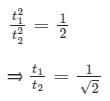Test: Introduction to Motion in a Straight Line - ACT MCQ
10 Questions MCQ Test Physics for ACT - Test: Introduction to Motion in a Straight Line
Which of the following are obtained by dividing total displacement by total time taken?
What kind of motion is rectilinear motion?
Which of the following types of motion cannot describe the motion of a clock’s hands?
In which of the following states does a body possess kinetic energy?
What is the rate of change of rate of change of displacement of a body?
When a body is in the state of complete rest, what kind of energy does it possess?
Which force can possibly act on a body moving in a straight line?
Which of the following types of motion can be used for describing the motion of a car on a straight road?
When two bodies move uniformly towards each other, the distance decrease by 6 m/s. If both the bodies moves (as above) in the same direction with the same speed, the distance between them increases by 4 m/s. Then the speed of the two bodies are
Two balls are dropped from heights h and 2h respectively. What would be the ratio of times taken by the balls to reach the earth?
|
169 videos|131 docs|69 tests
|





















